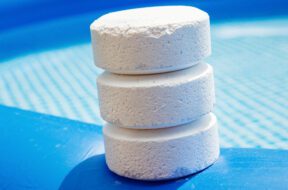
Want to learn more about algaecide? Read on to find out when to add algaecide to your pool maintenance routine and other helpful tips.
Selecting the right swimming pool sanitizer for your pool is as much about personal preference as it is about cost and benefits. Sanitizers come in liquid, powder, and tablet form, and many pool owners have questions about the differences between them. In this article, we will do our best to answer your questions.
If you would like a primer on types of chlorine before we begin, check out What is Free Chlorine, Combined Chlorine, and Total Chlorine It is also important to understand how other conditions of your pool effect chlorine before selecting the sanitizer that best suits you. You may want to check out our articles The Relationship Between Chlorine and pH and The Relationship Between Chlorine and Cyanuric Acid.
Chlorine gas is the most potent form of chlorine product as it is 100% chlorine. It is used by pool maintenance professionals and public pool complexes to raise free chlorine levels very efficiently, compared to chlorine acid liquid solutions. Even though chlorine gas is commonly used by professionals because of its efficiency in terms of both time and cost, it is probably overkill for most residential needs. Chlorine gas may also be dangerous and lead to poisoning if not handled correctly.
Chlorine tablets are an extremely common form of chlorine sanitizer for private and residential pools. Trichlor is cost effective in terms of both time and money because it is relatively inexpensive and can be passively dispersed.
The active ingredient, trichloro-s-triazinetrione (trichlor), is up to 90% chlorine which makes this form of sanitation highly efficient. The pH ofTrichlor is low, typically around 3, so you may need to add pH increaser to maintain pH balance between 7.2 and 7.8. The most important consideration when using chlorine tablets is to ensure they disperse as evenly as possible. It is ill-advised to simply toss them into your pool. Instead, we recommend using an automatic chlorinator. However, a simple chlorine dispenser is a suitable, more cost-effective option.
Sodium Hypochlorite, commonly referred to as liquid bleach, is a liquid sanitizer that is both very common among pool professionals and cost effective. In fact, it is the least expensive form of chlorine sanitizer. Pool professionals like liquid chlorine because they can add it in bulk, making it a great solution for larger commercial pools.
There are some drawbacks to using bleach on private residential pools, however. One drawback is that liquid bleach has a pH of 13 or higher. So, you will need to counter the pH effects of liquid bleach by adding acid. This reduces the overall cost benefit of liquid bleach. The other drawback is that liquid bleach can be highly corrosive to pool surfaces. If used improperly, the long-term costs of using liquid bleach can far outweigh the short-term savings.
Calcium Hypochlorite is the most popular powder sanitizer among private pool owners. It has a relatively high concentration of chlorine at 65% or higher and other than liquid bleach, it tends to be the most cost effective of chlorine sanitizers.
The primary things to be aware of are that cal-hypo will raise calcium hardness levels of your water. If water pool water stays too hard for too long, it can cause corrosion to the pool surface. Cal-hypo also has a high pH of about 12. So, acid will need to be added to maintain goal pH levels after adding cal-hypo.
Dichlor is perhaps the most “best of all worlds” chlorine sanitizer. Dichlor is:
One drawback of dichlor is that, like trichlor, it raises cyanuric acid levels. This may be a problem if cyanuric acid levels get too high and you must replace some of your water. Another drawback is dichlor tends to be quite a bit more expensive that cal-hypo.
Too expensive! Why get 50-lbs buckets of cal-hypo for $100 when you could get the same amount of lithium-hypo for $500?
Lithium hypochlorite is quite a bit more expensive than other sanitizers due to the high demand of lithium in other industries, particularly batteries. At 30-35% chlorine concentration, it is quite a bit weaker than some of the other solutions. However, it does have one primary benefit that has earned it a loyal following of one segment of pool owners. Lithium-hypo dissolves very quickly, which reduces the risk of bleaching effects in vinyl pools.

Want to learn more about algaecide? Read on to find out when to add algaecide to your pool maintenance routine and other helpful tips.

In this quick guide, we’ll answer the question “can you over shock a pool” and unveil the factors to consider when shocking a pool.

Maintaining both pH and total alkalinity in your swimming pool is important for keeping your pool properly sanitized and non-corrosive. Total alkalinity is to pH what cyanuric acid is to free chlorine. Total alkalinity stabilizes pH levels. The ideal pool pH level is 7.4 to 7.6. The ideal total alkalinity level is 80 to 120 ppm.

The Association of Pool and Spa Professionals recommends free chlorine levels for both swimming pools and hot tubs be kept between 2.0 and 4.0 ppm. However, the Center for Disease Control recommends free chlorine stay above 1 ppm in pools and 3 ppm in hot tubs.